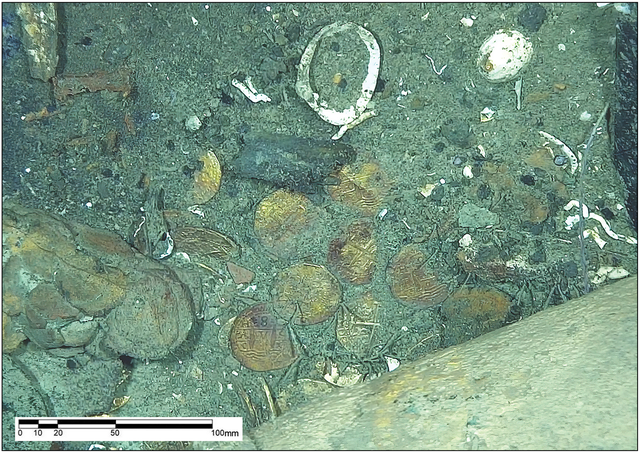New Insights into Legendary Shipwreck’s Golden Treasure
More than 300 years after the infamous Spanish galleon San Jose met its watery grave off the Colombian coast, researchers have revealed significant findings regarding the gold coins that lie scattered near the submerged vessel. Known as the “holy grail” of shipwrecks, the San Jose sank in 1708 during its journey back to Spain, laden with a fortune in gold, silver, and gems, ultimately costing the lives of most of its approximately 600 crew members.
Recent studies confirm that the intricately designed gold coins recovered from the shipwreck are indeed from the San Jose. The details carved into these coins include symbols such as castles, lions, and crosses on one side, with the “Crowned Pillars of Hercules” depicted against a backdrop of ocean waves on the reverse. This discovery was published in a recent article in the journal Antiquity.
The Shipwreck Discovery
An international team of researchers and Colombian navy experts utilized high-resolution images from remotely operated vehicles to analyze the coins found at depths nearing 2,000 feet. While the total quantity of coins on the seabed remains uncertain due to the constantly changing underwater environment, the investigation indicates each coin measures approximately 32.5 millimeters in diameter and weighs about 27 grams.
Some coins contained the letters “PVA,” which are associated with the Latin phrase “Plus Ultra,” meaning “Further Beyond.” This motto was often engraved on currency of the time to reflect the Spanish monarchy’s claim in the Atlantic. Additionally, inscriptions revealing the coins’ denominations and minting dates (1707) were identified.
History of the Coins
According to the authors of the study, coins from this historical era were usually struck from gold or silver ingots. Known in English as “cobs” and “macuquinas” in Spanish, these irregularly shaped, hand-struck currencies were the predominant form of money in the Americas for over two centuries.
| Feature | Details |
|---|---|
| Diameter | 32.5 mm |
| Weight | 27 grams |
| Minting Year | 1707 |
| Inscription | “PVA” and “Plus Ultra” |
Preservation Efforts and Legal Disputes
In August 2024, Colombian officials confirmed that a remotely operated vehicle successfully examined the wreck, revealing numerous artifacts, including an anchor and various glass bottles. The Colombian government has also announced plans to extract items from the site, which was first discovered in 2015. Despite this, the precise location of the wreck remains undisclosed in order to safeguard it from potential treasure-seeking expeditions.
The treasure from the San Jose has become the subject of multiple claims from various parties, including the Colombian government, Spain, and Indigenous groups who argue that the treasures rightfully belong to them. A U.S.-based salvage company, Sea Search Armada, has also laid claim to the wreck, asserting that it was the first to locate the site over four decades ago.
The circumstances surrounding the sinking of the San Jose remain contentious. While British documents suggest the vessel did not explode upon sinking, contradictory Spanish reports indicate an explosion during combat contributed to the loss. Regardless of the cause, the galleon, filled with chests of emeralds and over 200 tons of gold, perished on June 7, 1708.
In May 2024, the Colombian government designated the wreck site as a “protected archaeological area,” ensuring its preservation for future generations.




